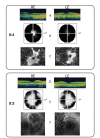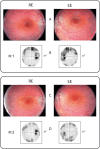Clinical and genetic studies in a family with a new splice-site mutation in the choroideremia gene
- PMID: 24672218
- PMCID: PMC3962727
Clinical and genetic studies in a family with a new splice-site mutation in the choroideremia gene
Abstract
Purpose: To describe the clinical and molecular findings of an Italian family with a new mutation in the choroideremia (CHM) gene.
Methods: We performed a comprehensive ophthalmologic examination, fundus photography, macular optical coherence tomography, perimetry, electroretinography, and fluorescein angiography in an Italian family. The clinical diagnosis was supported by western blot analysis of lymphoblastoid cell lines from patients with CHM and carriers, using a monoclonal antibody against the 415 C-terminal amino acids of Rab escort protein-1 (REP-1). Sequencing of the CHM gene was undertaken on genomic DNA from affected men and carriers; the RNA transcript was analyzed with reverse transcriptase-PCR.
Results: The affected men showed a variability in the rate of visual change and in the degree of clinical and functional ophthalmologic involvement, mainly age-related, while the women displayed aspecific areas of chorioretinal degeneration. Western blot did not show a detectable amount of normal REP-1 protein in affected men who were hemizygous for a novel mutation, c.819+2T>A at the donor splicing site of intron 6 of the CHM gene; the mutation was confirmed in heterozygosity in the carriers.
Conclusions: Western blot of the REP-1 protein confirmed the clinical diagnosis, and molecular analysis showed the new in-frame mutation, c.819+2T>A, leading to loss of function of the REP-1 protein. These results emphasize the value of a diagnostic approach that correlates genetic and ophthalmologic data for identifying carriers in families with CHM. An early diagnosis might be crucial for genetic counseling of this type of progressive and still untreatable disease.
Figures






Similar articles
-
Retinal dystrophy and subretinal drusenoid deposits in female choroideremia carriers.Graefes Arch Clin Exp Ophthalmol. 2017 Nov;255(11):2099-2111. doi: 10.1007/s00417-017-3751-5. Epub 2017 Jul 27. Graefes Arch Clin Exp Ophthalmol. 2017. PMID: 28752371
-
High-resolution images of retinal structure in patients with choroideremia.Invest Ophthalmol Vis Sci. 2013 Feb 1;54(2):950-61. doi: 10.1167/iovs.12-10707. Invest Ophthalmol Vis Sci. 2013. PMID: 23299470 Free PMC article.
-
Whole-exome sequencing reveals a novel CHM gene mutation in a family with choroideremia initially diagnosed as retinitis pigmentosa.BMC Ophthalmol. 2015 Jul 28;15:85. doi: 10.1186/s12886-015-0081-4. BMC Ophthalmol. 2015. PMID: 26216097 Free PMC article.
-
Molecular genetics characterization and homology modeling of the CHM gene mutation: A study on its association with choroideremia.Mutat Res Rev Mutat Res. 2018 Jan-Mar;775:39-50. doi: 10.1016/j.mrrev.2018.02.001. Epub 2018 Feb 18. Mutat Res Rev Mutat Res. 2018. PMID: 29555028 Review.
-
Choroideremia: new findings from ocular pathology and review of recent literature.Surv Ophthalmol. 2009 May-Jun;54(3):401-7. doi: 10.1016/j.survophthal.2009.02.008. Surv Ophthalmol. 2009. PMID: 19422966 Free PMC article. Review.
Cited by
-
Genetic analysis and clinical phenotype of two Indian families with X-linked choroideremia.Indian J Ophthalmol. 2016 Dec;64(12):924-929. doi: 10.4103/0301-4738.198866. Indian J Ophthalmol. 2016. PMID: 28112135 Free PMC article.
-
Is subretinal AAV gene replacement still the only viable treatment option for choroideremia?Expert Opin Orphan Drugs. 2021;9(1):13-24. doi: 10.1080/21678707.2021.1882300. Epub 2021 Mar 24. Expert Opin Orphan Drugs. 2021. PMID: 34040899 Free PMC article.
References
-
- Cremers FP, van de Pol DJ, van Kerkhoff LP, Wieringa B, Ropers HH. Cloning of a gene that is rearranged in patients with choroideraemia. Nature. 1990;347:674–7. - PubMed
-
- Ohba N, Isashiki Y. Clinical and genetic features of choroideremia. Jpn J Ophthalmol. 2000;44:317. - PubMed
-
- Garcia-Hoyos M, Lorda-Sanchez I, Gomez-Garre P, Villaverde C, Cantalapiedra D, Bustamante A, Diego-Alvarez D, Vallespin E, Gallego-Merlo J, Trujillo MJ, Ramos C, Ayuso C. New type of mutations in three spanish families with choroideremia. Invest Ophthalmol Vis Sci. 2008;49:1315–21. - PubMed
-
- Mauthner M. Ein Fall von Choroideremia. Naturwissenschaft. 1872;2:191–7.
-
- van Bokhoven H, van den Hurk JA, Bogerd L, Philippe C, Gilgenkrantz S, de Jong P, Ropers HH, Cremers FP. Cloning and characterization of the human choroideremia gene. Hum Mol Genet. 1994;3:1041–6. - PubMed
Publication types
MeSH terms
Substances
LinkOut - more resources
Full Text Sources
Research Materials

